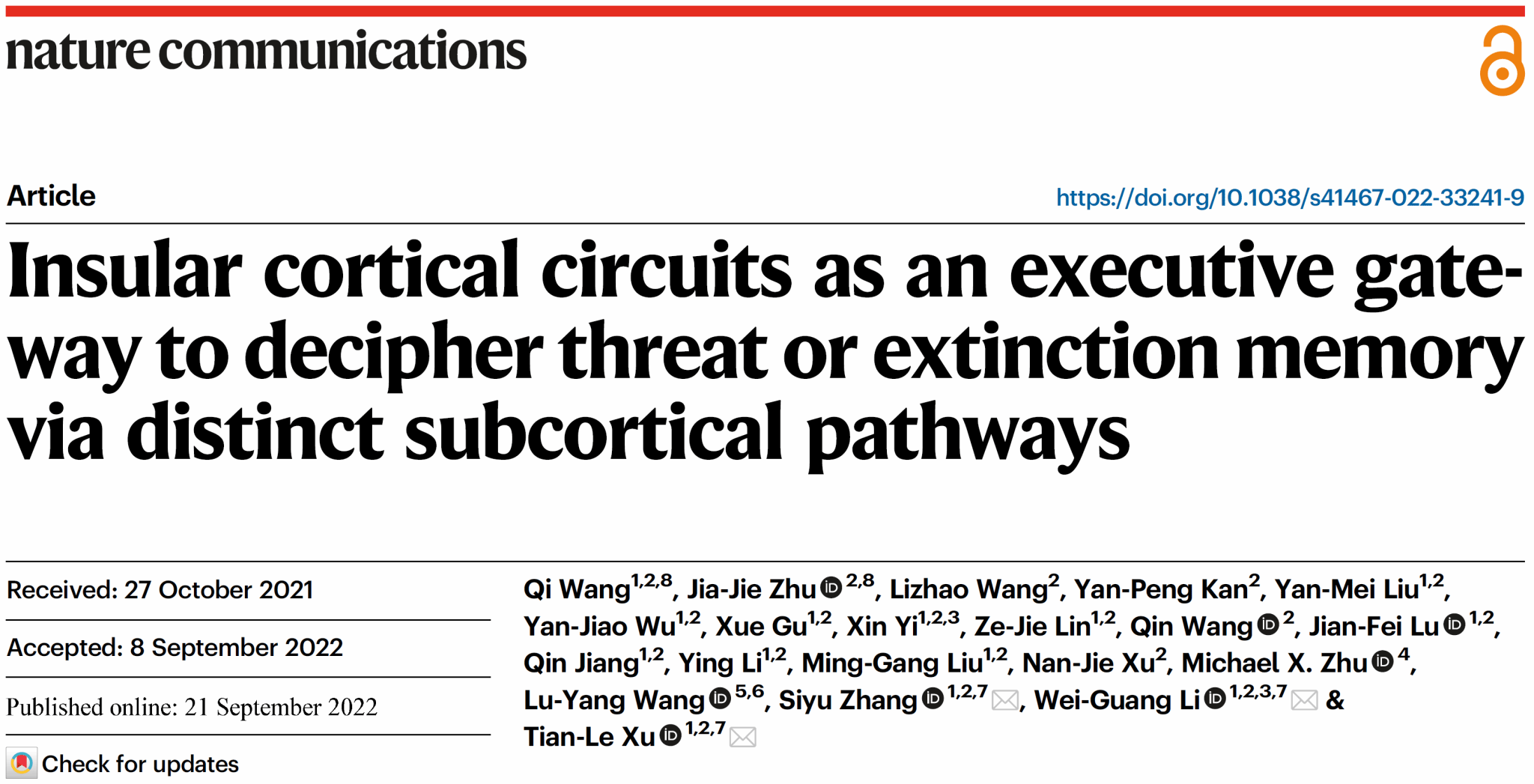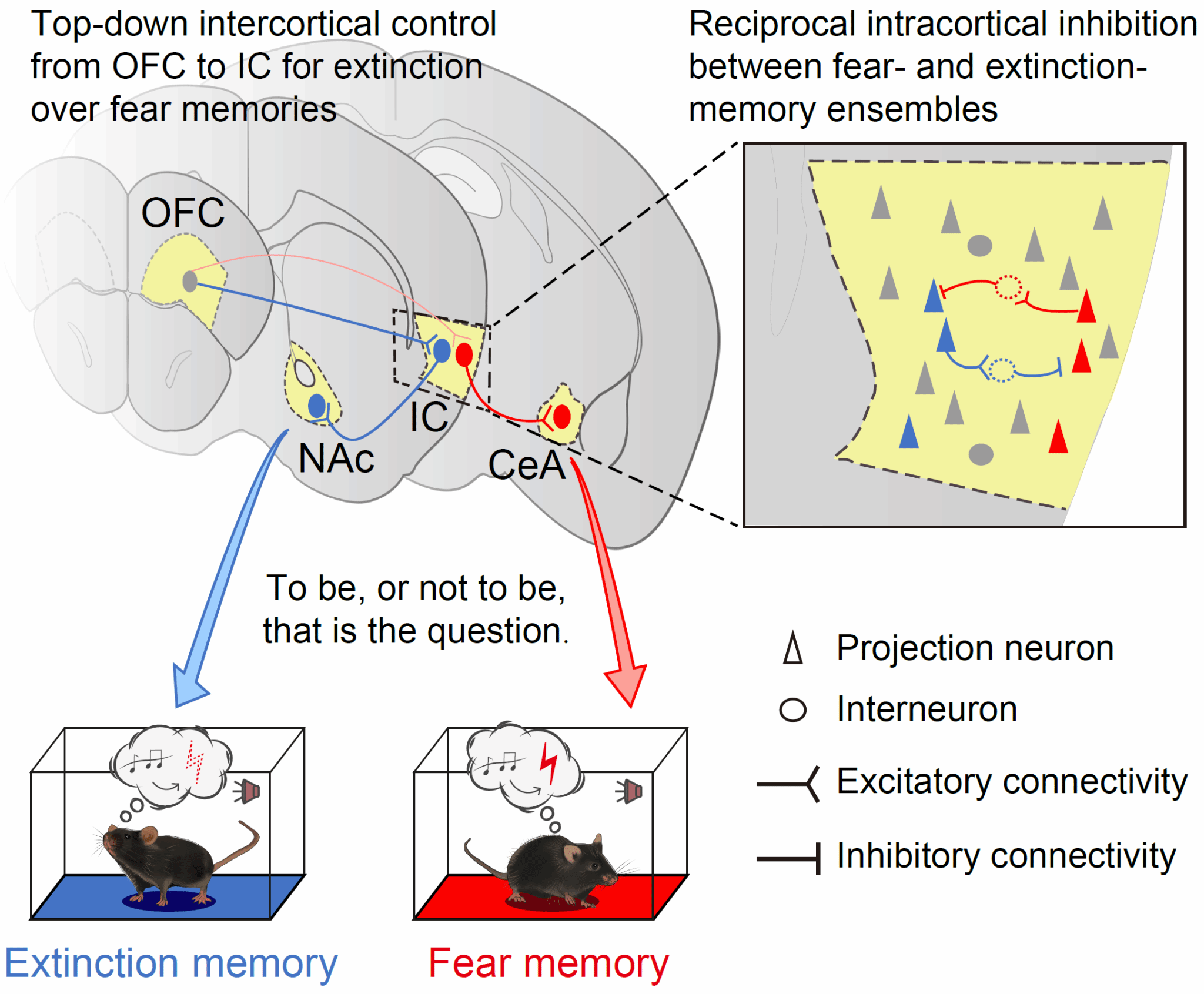On September 21, 2022, a collaborative study led by Prof. Wei-Guang Li from our institute, alongside Profs. Tian-Le Xu and Siyu Zhang from Shanghai Jiao Tong University School of Medicine and the Center for Brain Science at the National Children's Medical Center (Shanghai), was published online in Nature Communications. The paper, titled "Insular cortical circuits as an executive gateway to decipher threat or extinction memory via distinct subcortical pathways", leverages an array of cutting-edge neuroscience techniques to uncover distinct neuronal ensembles within the insular cortex (IC) that separately encode fear-related threat memories and safety-related extinction memories. Importantly, the study reveals the multi-tiered circuit principles—spanning cortico-cortical, intra-cortical, and cortico-subcortical layers—that orchestrate competitive interactions between these memory ensembles, providing a novel conceptual framework for understanding memory dynamics and complexity.

When faced with potential danger, humans and animals rapidly mount defensive behavioral responses and form robust fear memories to facilitate future threat avoidance. However, since threats are not continually present, organisms must flexibly suppress existing fear memories through a physiological process known as fear extinction, during which inhibitory extinction memories are formed to counterbalance established fears. Achieving equilibrium between fear and extinction memories is crucial for maintaining appropriate vigilance and adapting flexibly to a dynamically changing environment. While recent collaborative research from the Li, Xu, and Jiang groups systematically characterized the life-cycle of extinction memories at the engram-network level (Molecular Psychiatry, 2022), critical questions remained unresolved—particularly regarding how competing neuronal ensembles determine whether fear or extinction memories dominate behavioral responses at any given moment.
Employing the advanced targeted recombination in active populations (TRAP) technique at single-cell resolution, the researchers demonstrated that fear and extinction memories are separately encoded by distinct neuronal ensembles within the IC. This finding provides compelling evidence that extinction memories constitute novel and independent engrams rather than mere modifications or overwriting of pre-existing fear traces.
Using neural projection tracing techniques, the study revealed distinct downstream targets for these IC ensembles. Specifically, IC neurons encoding fear memories preferentially project to the central amygdala (CeA), while those encoding extinction memories predominantly project to the nucleus accumbens (NAc). These projection-defined neuronal populations—termed IC→CeA and IC→NAc ensembles—are anatomically segregated and functionally non-overlapping, selectively mediating fear and extinction behaviors, respectively.
Critically, the IC→CeA and IC→NAc ensembles exhibit mutual inhibitory interactions that are dynamically regulated by ongoing behavioral states. This reciprocal inhibition constitutes a neural switch mechanism within the IC, enabling organisms to competitively express either fear or extinction memories, thus dynamically toggling between negative and positive motivational states.
Using retrograde monosynaptic tracing methods across the whole brain, the research team identified stronger synaptic inputs originating from the orbitofrontal cortex (OFC)—a brain region critical for higher cognitive processing—onto extinction-encoding IC→NAc neurons. Furthermore, selective optogenetic activation of the OFC→IC or the complete OFC→IC→NAc pathway selectively promoted extinction memory expression. These results highlight a previously unappreciated top-down hierarchical control, wherein OFC projections preferentially bias cortical circuits toward extinction memory retrieval, offering executive-level regulation over memory competition.
Integrating these findings, the researchers propose a comprehensive circuit model (see schematic figure in the paper) to conceptualize how top-down OFC inputs operate as hierarchical gating mechanisms, sequentially regulating information flow through cortico-cortical, intra-cortical, and cortico-subcortical circuits. This organizational logic provides a foundational framework to systematically explore additional long-range cortical memory circuits, enhancing our understanding of how the brain computes opposing behaviors driven by identical external cues. Moreover, these findings hold significant translational potential, informing targeted therapeutic strategies aimed at intervening precisely in emotional and affective disorders.

Figure. Cortico-cortical, intra-cortical, and cortico-subcortical circuit organization underlying the distributed storage of fear and extinction memories.
Authorship and Acknowledgments:
Dr. Qi Wang, a postdoctoral fellow, and Mr. Jia-Jie Zhu, an undergraduate student from Zhiyuan College's Biomedical Sciences program, both affiliated with Shanghai Jiao Tong University, contributed equally to this work as co-first authors. Profs. Tian-Le Xu, Siyu Zhang, and Wei-Guang Li jointly supervised the research as co-corresponding authors.
The study was generously supported by multiple grants, including the Science and Technology Innovation 2030 Major Project ("Brain Science and Brain-Inspired Intelligence"), the National Natural Science Foundation of China, Shanghai Municipal Major Science & Technology Projects, key programs from the Shanghai Science and Technology Commission, Innovation Teams of the Shanghai Municipal Education Commission, the Shanghai Outstanding Academic Leaders Program, and the Original Exploration Youth Program of the Frontier Research Centre for Basic Medicine at Shanghai Jiao Tong University. Collaborative support also came from distinguished colleagues, including Academician Lu-Yang Wang (University of Toronto), Prof. Michael X. Zhu (UTHealth, Houston), and Prof. Nan-Jie Xu (Shanghai Jiao Tong University).
Link to original paper: https://doi.org/10.1038/s41467-022-33241-9